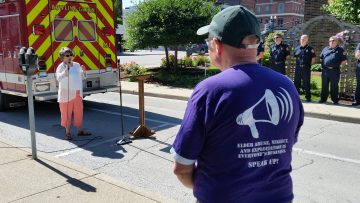By JAN LARSON McLAUGHLIN
BG Independent News
As local residents joined in the “Pause for the Pledge” of Allegiance on Thursday morning, they also pledged to protect vulnerable senior citizens from elder abuse.
Last year in Wood County, 338 cases of elder abuse, neglect and exploitation were investigated. That number had jumped from 260 cases the year before.
“No senior citizen should ever have to be worried about theft or abuse,” Wood County Prosecuting Attorney Paul Dobson said during a program outside the Wood County Senior Center.
Marc Briseno, supervisor of adult protective services in Wood County, said the number of elder abuse cases in the county continue to rise – probably due to the growing older population and the awareness being spread.
The number for people to report suspected abuse, neglect or exploitation is 419-354-9669.
Wood County Commissioner Doris Herringshaw talked about the overall impact of elder abuse – with approximately 5 million cases investigated every year nationally.
These are “valued members of our community,” she said.
Dobson referred to senior citizens as “precious gifts.”
“Everything that we have today is because of someone who came before us,” he said.
It is up to members of the community to be aware of elder abuse and neglect, and to report concerns so the prosecutor’s office can do its job to protect older residents, Dobson said.
“We in law enforcement will continue to defend our senior citizens,” he said.

Roger Anderson, dressed in an elder abuse awareness shirt, listens to Denise Niese.
State Sen. Randy Gardner and State Rep. Theresa Gavarone, both R-Bowling Green, commended Dobson for his efforts, and recognized Wood County Committee on Aging Executive Director Denise Niese for her recent state award for serving seniors.
Gardner and Gavarone mentioned the $1.6 million in state capital funds that will be put toward a new senior center in Bowling Green.
And Niese recognized the support of the community and elected officials in serving seniors. It takes a “team effort,” she said, to serve “the most vulnerable population.”
Following is a list from the Ohio Department of Job and Family Services on what is considered elder abuse:
- Neglect occurs when an individual’s basic needs for safety and well-being (such as medical care, adequate nutrition, socialization) are not being met. This can be through the action or inaction of the individual or another person.
- Exploitation is the unlawful or improper use of another person’s resources for monetary or personal benefit, profit or gain. People who exploit older adults can range from total strangers to trusted friends and family members.
- Physical abuse is the intentional use of physical force that results in injury, pain or impairment. It includes pushing, hitting, slapping, pinching and other ways of physically harming a person. In care settings, it can also include placing an individual in incorrect positions, force feeding, restraining or giving medication without the person’s knowledge.
- Emotional abuse occurs when a person is threatened, humiliated, intimidated or otherwise psychologically hurt. It includes the violation of an adult’s right to make decisions and the loss of his or her privacy.
- Sexual abuse includes rape or other unwanted, nonconsensual sexual contact. It also can mean forced or coerced nudity, exhibitionism and other non-touching sexual situations.
Warning signs of potential elder abuse, neglect or exploitation:
- Bruises, cuts or other signs of physical harm;
- Sudden behavioral changes, such as becoming less social;
- A caregiver who refuses to allow visitors to see the adult alone;
- Hazardous or unsanitary living conditions;
- Dehydration, malnutrition or poor personal hygiene;
- Previously uninvolved relatives showing sudden interest in the adult’s rights, affairs and possessions;
- Unexplained, sudden transfers of assets or finances to an individual;
- Unexplained disappearances of funds or valuable possessions;
- Abrupt changes in a will, financial documents, bank accounts or banking practice; and
- Over- or under-utilization of prescribed medications or missing medications.





